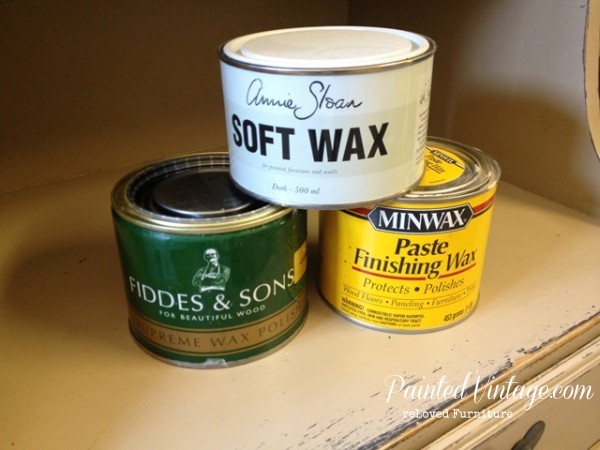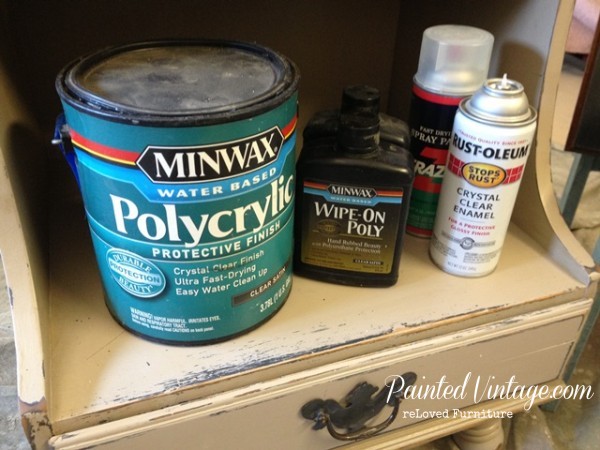To wax or not to wax?
Ah… The age old question: “To wax or not to wax over chalk paint?”
OK, so maybe it isn’t the question that’s been around for as long as chalk paint itself, but it is definitely a dilemma I’ve been facing more and more…
Nothing compares to the soft luster and rich glow of a freshly waxed piece of reLoved furniture!! However, applying wax over chalk paint is the most challenging, labor intensive and time consuming aspect of painting furniture with chalk and chalk-style paint.
Granted, not all waxes are created equal. Some waxes are downright difficult to work with and even require you to take a special class on proper application techniques.
Then there’s the durability issue.
Yes, I have an issue… Wax only offers minimal protection and wax is NOT permanent. Nor is it even semi-permanent. In fact, if it was a hair dye, it would be temporary!!
You see, wax wears off over time with use, leaving your beautiful chalk painted furniture all porous and exposed; a magnet for chocolaty little fingers and cheese puff smudges!
In order to maintain continued protection, wax needs to be reapplied every few months!
But wax isn’t THE ONLY option!
Why not go with a water-based polyurethane sealer, such as Varethane or Polycrylic over chalk paint?
These products are an excellent alternative, and offer far superior protection than a wax. A few coats of polycrylic will last YEARS beyond a few coats of wax, and can be much easier to work with.
Plus, polycrylics are more chemical resistant and are not heat sensitive like wax.
And unlike wax, if you ever chose to repaint your furniture, the polycrylic does not need to be 100% completely removed.
Don’t get me wrong, polycrylics are not without drawbacks.
Although they can have a yellowing effect over white and light colors, I personally have had good success with Varethane staying clear. Some waxes will yellow also, so that can still be an issue if you went that route. (I have also used clear spray-on sealers for smaller projects, with no issues what-so-ever!)
With the ease of application, I am finding water-based polyurethanes to be my go-to finish of choice over chalk painted furniture.
And if you are looking for a good alternative to do-it-yourself chalk-style paint, read my post on an Not So DIY Chalk Paint Recipe.
I’d love to hear your feedback! What is your sealer of choice over chalk paint and chalk-style paint on your reLoved furniture, and what, if any, challenges do you face?
**UPDATE**
Still have questions?? I posted an update with answers to all the most commonly asked questions I’ve received.
You can read it here: “Wax or Polycrylic Over Chalk Paint?”







Hi! I am going to venture into painting a kitchen table today… I am painting it a lighter gray. Since this will be an item that gets a lot of use and cleaning often, what kind of sealer do you reccomend? Thank you!
Personally, I would not use a wax on a kitchen table. I would use Varethane.
Hello! First, thanks a lot for this information, it will be very useful, as I wasn’t convinced about using the wax in furniture. But what about fabric and upholstery? I am thinking of painting some chair cushions, and wax would look and feel ok (I think), but it won’t be durable, is there any other product I could use?
Thank you very much!
Hello!! I have never painted fabric or upholstery. I have seen other do it with success, but I’m afraid I cannot be of any help on that subject- sorry!
Hi i have question, how soon can you color with annie chuck paint after wax?
I have a durability question….. I usually go through the trouble to strip existing finishes on furniture then use oil based paint because I like the hard, durable enamel finish. I have a dresser that I would like to not strip first then use the chalk paint and water based poly option. Will the finish with the water based poly be as hard as enamel? I have things that sit on top of that dresser and I don’t want to have any tackiness to the finish like you would get with latex
Hi Lauren, I don’t personally find the water-based poly’s to be as hard as enamel. However, it still is a very strong and durable finish. Once the finish is fully cured, you should have no problems with tackiness and setting / moving items around the top of your dresser. It will not be like a latex paint finish would be.
Just finished painting a table with homemade chalk paint and was amazed at how the paint covered so well. Lowes sell a Valspar color sample for $3.00. I mixed 1/2 cup of baking soda with 3 Tbsp of water and mixed together well and then poured my paint in and mixed well. Now I want to keep this look but need a coat of protection on it . What is the best way to do this ? I need reply ASAP BECAUSE I AM SO EXCITED TO GET THIS DONE . Thank you so much !!
Hi Sherri, I just used pure white on a dresser and right before I started applying polycryllic I found your comments about it yellowing. Yikes! Of the alternatives you’ve mentioned, is there a good one that keeps the soft matte finish(rather than shiny/glossy?) I’m so glad I found your site!!
Hi Terri- Thank you! The Varathane water based polyurethane comes in a soft matte finish. You might want to look into that. Good Luck!
Thanks a million!
Hi, I’m painting some chairs this weekend with DIY white chalkpaint in a Harbor Freight sprayer. For the “sealer”, I’d like to try to use the Varethene brand you recommended since it doesn’t yellow; however, there seem to be several options. Which product in particular have you tried that doesn’t yellow? Hopefully they have it available in a spray can too.
I just painted my coffee table with Chalk Paint and am on to the sealing step. I used a spay-on poly from Rust-Oleum just like the one in your picture. It worked great on the legs and small surfaces, leaving a glossy layer that nicely covered up the chalky/dusty look. It also made the color look richer, not to mention, gave a protective coat.
Unfortunately, it did not go over well on the coffee table-top…it was very hard to get an even coat and seemed to absorb inconsistently. There are now glossy splotches as if I sprayed un-evenly. Which maybe I did, but I went over it several times and still can’t get it consistent and all glossy.
I am thinking about getting the Varathane Poly from Rust-Oleum in an actual can/container and applying with a brush so I can get an even coat on the top and get rid of the spots. The spray can is just not working for the big surface areas.
Is this the right decision??
Thanks!
I too am chalk painting a turquoise color and want to distress the edges but am curious to wax it on or doing the polyurethane. Which do you think would be better? And should I buy the dark wax and the clear and do them after I seal it?
Here’s some info on how wax cures on top of paint, for those who are curious how wax behaves over paints:
http://paintminerals.com/?p=156
Hi! This blog helped me so much! I was wondering…. I amusing a white chalk paint on my kitchen table but I want to use a glaze and then, per your suggestion, of 3 top coats of the Varathane Diamond Wood Finish. My question is… ” what color should I mix with the glaze to get a slightly antiqued look, and does the Varathane come in a matte finish, so the table still has the chalk paint-look?”
Thanks!
I just painted my kitchen cabinets with diy chalk paint, after the cabinets dried I applied asmall amount of past wax rubbed in followed by mini-wax stain. I plan to lightly sand and apply a couple of coats of poly (clear satin). Since these are kitchen cabinets I want them to have more protection and didn’t want the wax to soften. I rubbed both the wax and stain together with a cotton rag/cheese cloth. I just read here that I can’t apply the poly over wax… since I didn’t use that much, will this be an issue?
Hi Tess- I would try and remove the wax before applying poly over it.
We paint every day and have moved pretty much away from the wax finishes mainly because they are not as durable as a poly and when I sell something – I want it to be as maintenance free and long lasting to the customer as possible. We HVLP spray 90% of our products in latex and do the occasional homemade chalk paint (using calcium carbonate) when I have an off color or singular piece and the booth is full. It’s a good quick alternative. My choice top coats are poly (Polycrylic of General Finishes High Performance) or lacquer and I’ve not had issues with yellowing at all. I do poly over chalk paint and when I need a darker antiqued look – it’s either glaze or Danish oil and then poly / lacquer. I can get the exact same look as a chalk finish / wax in a more durable finish. I have had some folks come in and give me the heresy look when I talk about waxing not being as durable as a poly but it’s OK.
Mary, would you share what glaze you use prior to poly? I just chalk painted my “80s” oak hutch a taupe/tan with cream on the inside / open shelvins. Very happy. I distressed and waxed the tan areas and love the look. I’m not concerned about the wax holding up as I’m really the only one “handling” the hutch. Now I want to chalk paint my table and chairs cream, but need to give them a little aged color here and there along with the distressing on the edges. Hoping your suggestion of glaze before poly would be my answer! So, a good glaze produce would be ???? Thanks!
Thanks for sharing, Mary… I’m getting the heresy look now, from the anti-poly police!! LoL!!!
LoL!!!
I am painting a round farm tsble that is wood. However, the top of the table is both wood with tiles inserted/imbedded on top. I painted over the tiles and varnished the wood. My question is I think I will be going over it with the water based poly. Is it ok to go over both the tiles and the wood with the poly? Thanks for all your help.
I want to antique the finish over chalk paint but I don’t want to use dark wax, or the clear for that matter. I plan on following your suggestion of using poly for the top coat. What should I do to put an antiquing effect over the paint before sealing?
Michele
Do you sand before poly? Do you sand between coats of poly? How many coats did you do of poly?